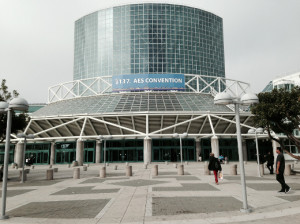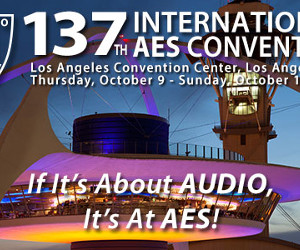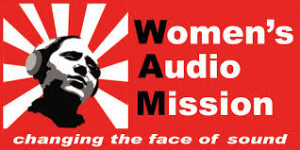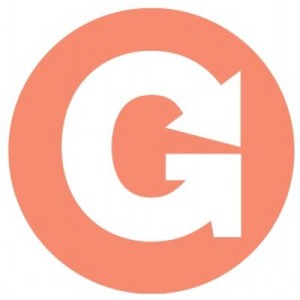137th AES in Review: What Happened in the Return to Los Angeles?
AES in LA rolls off the tongue nicely…and it sounds like the chorus of a breezy hit tune in the making.
Anyone want to collaborate on this ditty? I’m not sure that anyone’s ever written a song about the annual Audio Engineering Society convention, and if they haven’t, it’s a serious oversight.
Of course, it had better be recorded extremely well.
Such a project would be a welcome diversion for the attendees of this year’s 137th AES Convention, which just wrapped up after four days in the sunny City of Lights. That’s because if you put a heart rate monitor on the conference, it would beat a steady pulse: Nobody got too high, nobody got too low. 2014 was business as usual for audio.
Back Where It Belonged
And don’t take that as a knock. Sometimes, business as usual can feel like a good thing. Technological breakthroughs drive and excite the audio industry, but you can’t have a major development every year.
There were many beautiful things to see, touch, and listen to (the actual order in which we experience things at AES) at this year’s show. Some were hardware, some were virtual, and seemingly all of it is being made to increasingly higher standards.
Joining the exhibitors and technical presenters were an involved crowd. The return of the show to LA brought a convenient sense of relief to the thousands in the area who got their audio convention back, after a decade plus in San Francisco.
To say that Los Angeles is a natural host city for AES is to state the obvious. The huge amount of commercial recording, audio post, software development, and hardware manufacturing in the area have a real use for the show’s return to their downtown backyard. Several LA studios stand among the most revered in the world – and many of them were accessible to a global guest list for the first time in a while, throwing memorable evening parties that packed La La land’s extra glamor.
Inside the Las Angeles Convention Center, the crowds thickened and thinned, but the energy was always at least decent, and a product rollout or celebrity producer/engineer interview had the power to block an aisle way completely. Meanwhile, it seems like there were a few more exhibitors for them to visit — the hall appeared booked to all sides.
What Stood Out
In our time there, we saw some patterns emerge. Here were some themes bubbling over and under the surface at the 137th AES:
Software Updates – there may be a lot of program shops that are pros at writing supreme code, but they’re still trying to figure out the puzzle of how best to get their users to pay for their programs.
For instance, far from being happy about persistent major updates to their favorite DAWs, effects, and synths, there is a growing contingent that actually resents them. Apparently, even though we like our consumer electronics to change at light speed, we wish our professional software wouldn’t move quite so fast – it can be expensive and time consuming to upgrade every year, on the year.
While developers check their product cycle pacing, many are also examining alternative pricing strategies altogether. Subscription models were on the lips of more than one developer at the show, as audio seriously investigates whether the Adobe Photoshop type software-as-a-membership model (cloud applications and storage, constant updates, support) may apply in the audio vertical as well.
Craftsmanship – on the other side of the aisle, the hardware remains a fascinating – and aesthetically pleasing – aspect of AES. Beautiful gear that looks neat, is sweet to the touch, and sounds great appeals to what may be an expanding group of customers.
While it’s true that there is more and more inexpensive equipment available to the beginners and “good-enough” users in the market, some of these people have to move up eventually. Call them enthusiasts, a hybrid group of artist/engineers/producers who want to improve their recordings, mixes, and mastering. Everyone knows what a few choice pieces of analog gear can do for your DAW-based signal chain, and AES is a great way to see many choices in one place, explained by the creators themselves.
In turn, you can see the real craftsmanship being practiced today by the men and women who make mic pres, compressors, EQ’s, microphones, monitors, plugins, and more. There’s beautiful circuitry on display everywhere at AES, and it’s getting better all the time.
Still, are there enough users here to build an entire industry on? Will AES itself ever get any bigger off the strength of this audience?
The pirate ship is slowly sailing – reinforcements are coming to the audio industry, thanks to a growing female presence.
A more co-ed representation was seen on the floor, but that’s just a part of what’s going on. Audio schools are actively courting female students, assuring them that they’ll feel comfortable in the program, and their marketing efforts are paying off. As one audio professor told me, female students no longer “feel weird for being there,” and are enrolling in ever-larger numbers.
Furthermore ongoing efforts by determined groups like the Women’s Audio Mission and Beats by Girlz have lifted up the other 50%. After being virtually locked out of audio engineering for the entire history of the field, women are breaking down the gates.
New platforms – of course, hardware and software only have so much to do with what’s next. There is a whole wave of applications on the way to completely reshape the audio production landscape.
Collaborative online workflows, after being relatively dormant for many years, have experienced a strong resurgence recently. Services like Blend and Splice have both seen how the robustness of Ableton Live makes it a welcoming host for new types of cyberspace production. If these two, and the more to come, get it right this time the new global production of music would reasonably impact the tools required to get it right.
One such system may be sitting in your pocket right now. The file-sharing cloud platform Gobbler marked the release of Gobbler 2.0 at AES. That’s where the company’s founder, Chris Kantrowitz, told me that there are now over 500 apps for music-making available on the Apple store.
To him, the day where a #1 hit is written and recorded completely on an iPhone isn’t far off – how will that milestone reshape the audio production landscape?
Avid is suing Gobbler – speaking of Gobbler, the company is the subject of a new federal lawsuit by Avid. In a story first broken to the pro audio community by Pro Tools Expert, Burlington, MA-based Avid accused California-based Gobbler of intellectual property violations. At issue is Gobbler’s hiring away four Avid employees, right after Avid announced on May 15 that it was going to offer its own online file-sharing service.
The matter is complicated, and could wind up taking a torturous road through the courts. Whatever your opinion of the lawsuit’s merits, it was interesting for many to see Avid back on the offensive.
Avid’s reward for designing, maintaining, and evolving the ultimate audio category killer has been a brand battering. Recording, audio post, broadcast – you name it – owes its life to Avid products, which engenders a love/hate relationship from there. Avid-bashing is fun and easy, and all the company could do in return was grin, bear it, and just keep on selling its essential products and services.
Now it’s Avid’s turn to strike back, and they’re taking on a potential competitor that’s aiming to fundamentally disrupt audio’s file-management infrastructure. Here’s one thing at stake for both sides: Big data is increasingly valuable, and sophisticated file-sharing services can provide it.
How do you feel about your plugin provider getting a file on every single setting you’ve ever designed inside your delay? These new platforms aim to divulge that data to plugin developers for a price. They’ll also happily sell you a new plugin through their online store, if for instance your collaborator has the PlasmaBlaster limiter and you don’t.
All this and more is probably on the way. The loss of your production privacy will be followed by new plugins analyzed to the nth degree, and better molded to work the way you want them to. Is that a fair tradeoff? You will be deciding soon enough.
Relevance resurgence — The AES, which has long-craved street cred with the younger generation of engineers, may finally be getting its wish. Not only did plenty of polite young men and women wonder the exhibit aisles, but they were actively engaged in the comprehensive technical program from the AES’ various committees.
The program included tracks for broadcast and streaming, game audio, live sound, networked audio, product design, recording production, and sound for picture. There was a Project Studio Expo and a Live Sound Expo, apps and events.
Next to me at breakfast one morning, a group of three young attendees worried over the day’s program, trying to resolve overlapping workshops of interest. Another time, I overheard a youthful AES member explaining his strategy for moving up in the organization. His female counterpart responded that the 2015 AES was already set in her schedule, and “for the years after that.” It’s next-gen feedback that speaks for itself.
Take TN
In 2015, AES will be back in its East Coast home of Manhattan. That’s nice, but how about breaking the bi-coastal box, and slating a near-future show for Nashville? Music City would be a most gracious host, and I for one would love an AES excuse to explore that city’s legendary studios and rich culture.
I noticed something funny just now. Even though I’ve been back in NYC for two days, I still haven’t changed my computer’s clock back from California time. I’m sure many agree – Los Angeles for 2014 felt right for business as usual.
— David Weiss
(Stay tuned for our gear highlights from this year’s show — still to come!)
Please note: When you buy products through links on this page, we may earn an affiliate commission.











Shane McGill
October 14, 2014 at 2:54 pm (10 years ago)Great article, alas, really how old is the computer you’re using that you’ll have to change time manually 😉
David Weiss
October 15, 2014 at 12:13 pm (10 years ago)I heart my Commodore 64!
Tommy Lockett
October 15, 2014 at 11:10 pm (10 years ago)Why move AES from LA, it was the best show in years IMO, and speaking with many of the companies, they felt the same way, Nashville could be interesting alternative to NYC